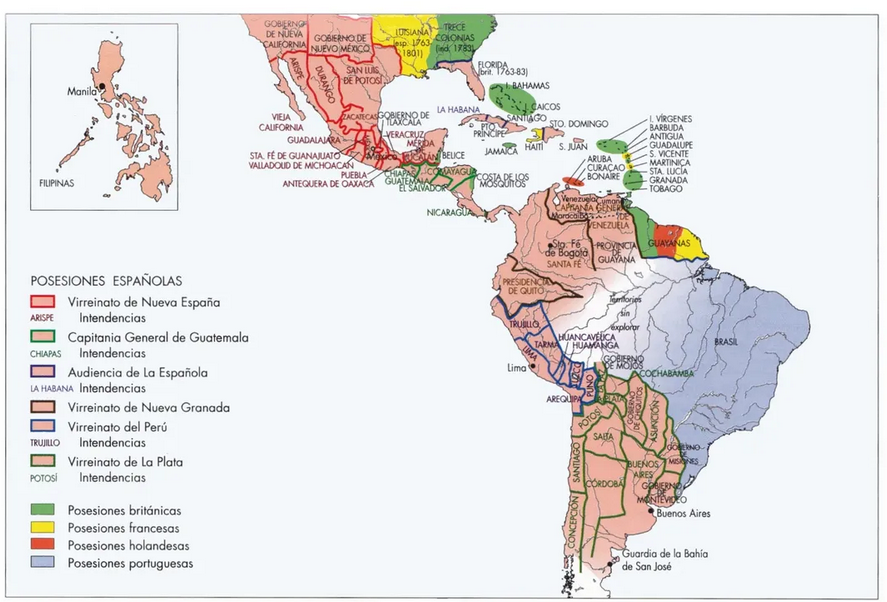Spanish Colonies in the Americas Map


David Chen
Data Visualization Specialist
David Chen is an expert in transforming complex geographic datasets into compelling visual narratives. He combines his background in computer science ...
Geographic Analysis
What This Map Shows
This map provides a detailed visualization of the Spanish colonies in the Americas during the 18th century, illustrating the vast territorial reach of Spanish rule across North, Central, and South America. It highlights key regions, including New Spain (which encompassed present-day Mexico and parts of the United States), Peru, and the Caribbean islands, revealing the extensive influence and administrative structure of the Spanish Empire at that time.
Deep Dive into Spanish Colonial Territories
The 18th century was a crucial period for the Spanish Empire, marked by a significant expansion of territories through exploration, conquest, and colonization. The Spanish colonies in the Americas were not merely land holdings; they were vibrant centers of culture, economy, and governance that shaped the history of the continent.
Interestingly, New Spain was one of the largest and most valuable colonies, rich in resources like silver, sugar, and tobacco. The mining boom in places like Zacatecas and Potosí made New Spain the backbone of the Spanish economy and significantly contributed to the wealth of the empire. In fact, by the late 16th century, Potosí alone was producing a staggering amount of silver, which played a pivotal role in global trade networks.
Additionally, the Spanish established a complex administrative system to manage these vast territories. The colonies were divided into viceroyalties, each governed by a viceroy who acted on behalf of the Spanish crown. The Viceroyalty of Peru, for instance, was established in 1542 and was crucial for governing South America, while the Viceroyalty of New Granada was created in 1717 to oversee territories that are now Colombia, Ecuador, Panama, and Venezuela.
Throughout this time, the Spanish also implemented the encomienda system, which allowed colonists to demand labor and tribute from Indigenous peoples in exchange for protection and Christianization. This system had profound implications for Indigenous populations, leading to significant demographic shifts due to disease, displacement, and exploitation. Interestingly, by the end of the 18th century, the demographic landscape had changed drastically, with mixed-race populations (mestizos) beginning to emerge as a dominant demographic group in many regions.
Regional Analysis
When we analyze the various regions illustrated in the map, intriguing patterns emerge. In the Caribbean, for example, colonies like Cuba and Puerto Rico were primarily focused on sugar production, which became the primary commodity for trade. The strategic location of these islands made them essential for the Spanish trade routes, linking Europe, Africa, and the Americas. Conversely, in the southern regions, particularly in Peru and Chile, agriculture and mining dominated, with vast estates producing crops like corn and potatoes, while silver mining in Potosí continued to thrive.
In contrast, the northern territories, such as present-day Texas and parts of California, were less populated and less economically developed compared to their southern counterparts. These areas were often riddled with conflicts between Indigenous tribes and Spanish settlers, leading to a slower colonial expansion. The differences in economic activities and demographic composition across these regions reflect the complexity of Spanish colonial rule and its adaptations to local conditions.
Significance and Impact
Understanding the Spanish colonies in the Americas is essential for grasping the historical context of modern Latin America. The legacies of colonialism, including language, culture, and social structures, continue to influence these regions today. For instance, Spanish remains the dominant language in most of Latin America, and many cultural practices can be traced back to this colonial period.
Moreover, the colonial economy laid the groundwork for the contemporary economic frameworks seen across the region. The reliance on agriculture and mining established patterns that persist, with many countries still depending on these sectors for economic stability. Have you noticed how some Latin American economies still grapple with issues linked to their colonial past?
Looking ahead, the ongoing discussions surrounding colonial legacies, social equity, and economic development in Latin America reflects the profound impact of this historical period. Understanding these dynamics is crucial as countries navigate the challenges of globalization and seek to forge their identities in a modern world.
In conclusion, the Spanish colonies in the Americas map not only serves as a historical record but also as a lens through which we can understand the complexities of colonial influence that shaped the continent's development. As we delve into this rich tapestry of history, it’s important to recognize the continuing reverberations of these past events in our present-day society.
Visualization Details
- Published
- August 13, 2025
- Views
- 122
Comments
Loading comments...